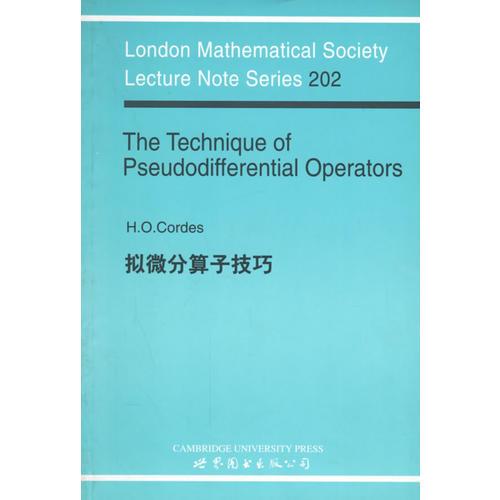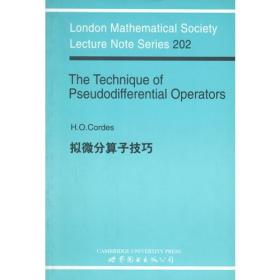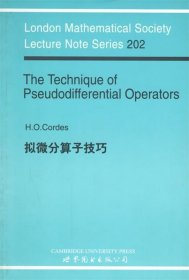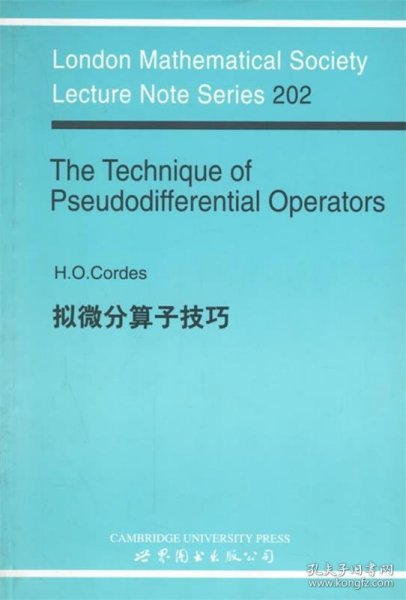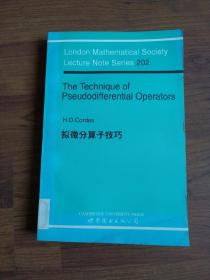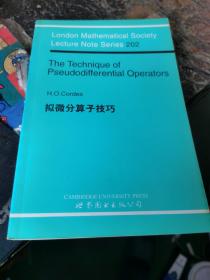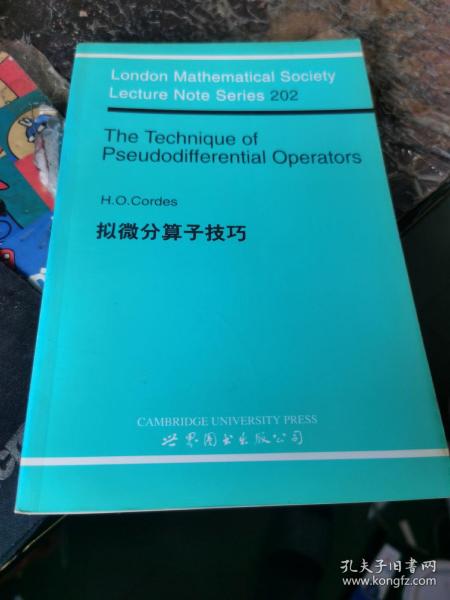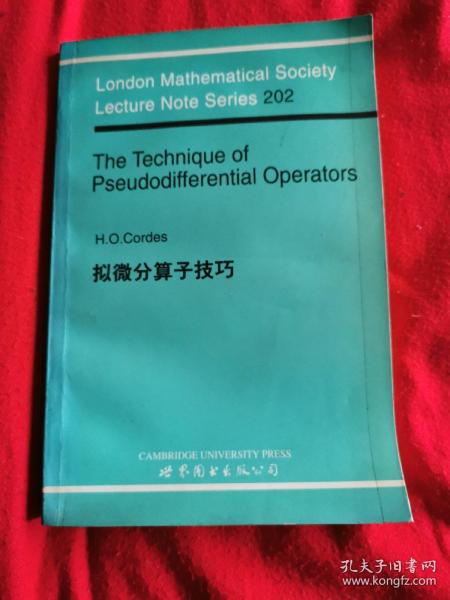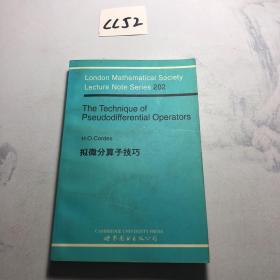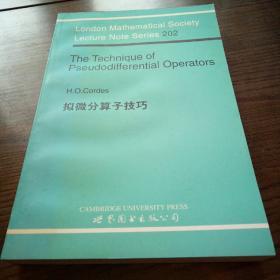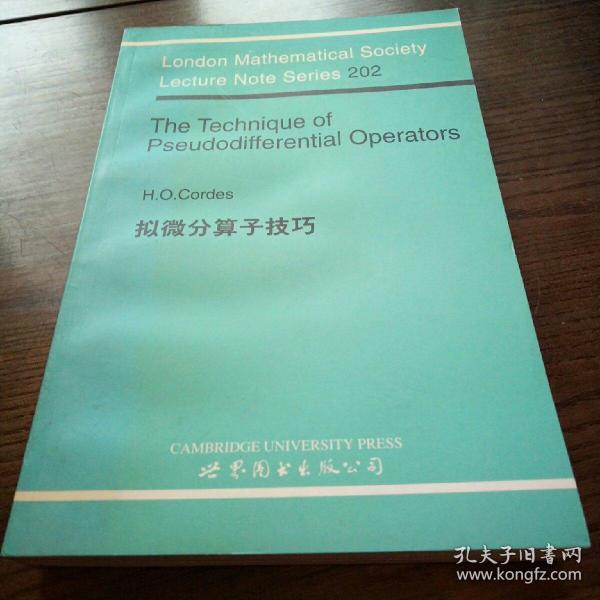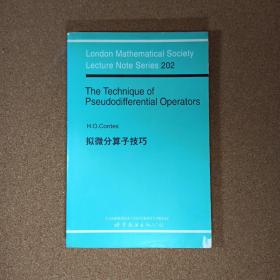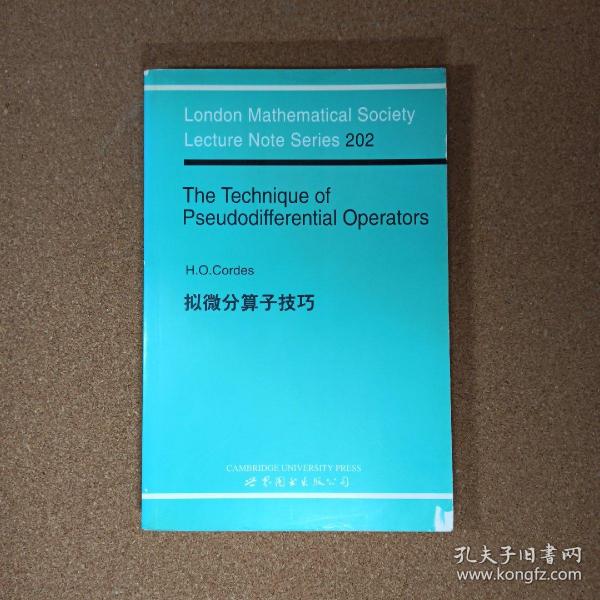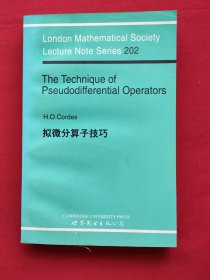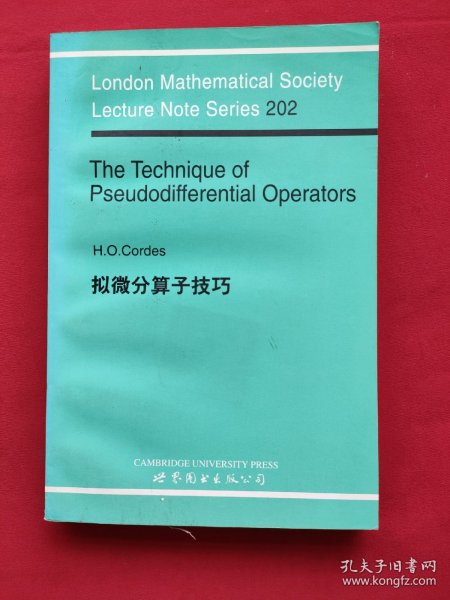拟微分算子技巧(英文版)
出版时间:
2000-06
版次:
1
ISBN:
9787506246989
定价:
59.00
装帧:
平装
开本:
其他
纸张:
胶版纸
页数:
382页
12人买过
-
It is generally well known that the Fourier-Laplace transform converts a linear constant coefficient PDE P(D)u=f on Rn to an equation P(§)u-(§)=f-(§), for the transforms u-, f- of u and f,so that solving P(D)u=f just amounts to division by the polynomial P(§). The practical application was suspect, and ill understood, however, until theory of distributions provided a basis for a logically consistent theory. Thereafter it became the Fourier-Laplacemethod for solving initial-boundary problems for standard PDE. We recall these facts in some detail in sec's 1-4 of ch.0. Chapter 0. Introductory discussions
0.0. Some special notations, used in the book
0.1. The Fourier transform; elementary facts
0.2. Fourier analysis for temperate distributions on Rn
0.3. The Paley-Wiener theorem; Fourier transform for general u∈D''
0.4. The Fourier-Laplace method; examples
0.5. Abstract solutions and hypo-ellipticity
0.6. Exponentiating a first order linear differential operator
0.7. Solving a nonlinear first order partial differen-tial equation
0.8. Characteristics and bicharacteristics of a linear PDE
0.9. Lie groups and Lie algebras for classical analysts
Chapter 1. Calculus of pseudodifferential operators
1.0. Introduction
1.1. Definition of do''s
1.2. Elementary properties of do''s
1.3. Hoermander symbols; Weyl do''s; distribution kernels
1.4. The composition formulas of Beals
1.5. The Leibniz'' formulas with integral remainder
1.6. Calculus of do''s for symbols of Hoermander type
1.7. Strictly classical symbols; some lemmata for application
Chapter 2. Elliptic operators and parametrices in Rn
2.0. Introduction
2.1. Elliptic and md-elliptic do''s
2.2. Formally hypo-elliptic do''s
2.3. Local md-ellipticity and local md-hypo-ellipticity
2.4. Formally hypo-elliptic differential expressions
2.5. The wave front set and its invariance under do''s
2.6. Systems of do''s
Chapter 3. L2-Sobolev theory and applications
3.0. Introduction
3.1. L2-boundedness of zero-order do''s
3.2. L2-boundedness for the case of >0
3.3. Weighted Sobolev spaces; K-parametrix and Green inverse
3.4. Existence of a Green inverse
3.5. Hs-compactness for do''s of negative order
Chapter 4. Pseudodifferential operators on manifolds with conical ends
4.0. Introduction
4.1. Distributions and temperate distributions on manifolds
4.2. Distributions on S-manifolds; manifolds with conical ends
4.3. Coordinate invariance of pseudodifferential operators
4.4. Pseudodifferential operators on S-manifolds
4.5. Order classes and Green inverses on S-manifolds
Chapter 5. Elliptic and parabolic problems
5.0. Introduction
5.1. Elliptic problems in free space; a summary
5.2. The elliptic boundary problem
5.3. Conversion to an Rn-problem of Riemann-Hilbert type
5.4. Boundary hypo-ellipticity; asymptotic expansion mod v
5.5. A system of de''s for the j of problem 3.4
5.6. Lopatinskij-Shapiro conditions; normal solvability of 2.2 .
5.7. Hypo-ellipticity, and the classical parabolic problem
5.8. Spectral and semi-group theory for do''s
5.9. Self-adjointness for boundary problems
5.10. C-algebras of do''s; comparison algebras
Chapter 6. Hyperbolic first order systems
6.0. Introduction
6.1. First order symmetric hyperbolic systems of PDE
6.2. First order symmetric hyperbolic systems of de''s on Rn.
6.3. The evolution operator and its properties
6.4. N-th order strictly hyperbolic systems and symmetrizers.
6.5. The particle flow of a single hyperbolic de
6.6. The action of the particle flow on symbols
6.7. Propagation of maximal ideals and propagation of singularities
Chapter 7. Hyperbolic differential equations
7.0. Introduction
7.1. Algebra of hyperbolic polynomials
7.2. Hyperbolic polynomials and characteristic surfaces
7.3. The hyperbolic Cauchy problem for variable coefficients
7.4. The cone h for a strictly hyperbolic expression of type e
7.5. Regions of dependence and influence; finite propagation speed
7.6. The local Cauchy problem; hyperbolic problems on manifolds
Chapter 8. Pseudodifferential operators as smooth operators of L H
8.0. Introduction
8.1. do''s as smooth operators of L HO
8.2. The DO-theorem
8.3. The other half of the DO-theorem
8.4. Smooth operators; the *-algebra property;do-calculus
8.5. The operator classes GS and GL, and their symbols
8.6 The Frechet algebras X0'' and the WeinsteinZelditch class
8.7 Polynomials in x and x with coefficients in GX
8.8 Characterization of GX by the Lie algebra
Chapter 9. Particle flow and invariant algebra of a semi-strictly hyperbolic system; coordinate invariance of Opxm.
9.0. Introduction
9.1. Flow invariance of 10
9.2. Invariance of sm under particle flows
9.3. Conjugation of Opx with eiKt, K∈ Opce
9.4. Coordinate and gauge invariance; extension toS-manifolds
9.5. Conjugation with eiKt for a matrix-valued K=k x,D
9.6. A technical discussion of commutator equations
9.7. Completion of the proof of theorem 5.4
Chapter 10. The invariant algebra of the Dirac equation
10.0. Introduction
10.1. A refinement of the concept of observable
10.2. The invariant algebra and the Foldy-Wouthuysen
transform
10.3. The geometrical optics approach for the Dirac algebra P
10.4. Some identities for the Dirac matrices
10.5. The first correction z0 for standard observables
10.6. Proof of the Foldy-Wouthuysen theorem
10.7. Nonscalar symbols in diagonal coordinates of h x,§
10.8. The full symmetrized first correction symbol zS
10.9. Some final remarks
References
Index
-
内容简介:
It is generally well known that the Fourier-Laplace transform converts a linear constant coefficient PDE P(D)u=f on Rn to an equation P(§)u-(§)=f-(§), for the transforms u-, f- of u and f,so that solving P(D)u=f just amounts to division by the polynomial P(§). The practical application was suspect, and ill understood, however, until theory of distributions provided a basis for a logically consistent theory. Thereafter it became the Fourier-Laplacemethod for solving initial-boundary problems for standard PDE. We recall these facts in some detail in sec's 1-4 of ch.0.
-
目录:
Chapter 0. Introductory discussions
0.0. Some special notations, used in the book
0.1. The Fourier transform; elementary facts
0.2. Fourier analysis for temperate distributions on Rn
0.3. The Paley-Wiener theorem; Fourier transform for general u∈D''
0.4. The Fourier-Laplace method; examples
0.5. Abstract solutions and hypo-ellipticity
0.6. Exponentiating a first order linear differential operator
0.7. Solving a nonlinear first order partial differen-tial equation
0.8. Characteristics and bicharacteristics of a linear PDE
0.9. Lie groups and Lie algebras for classical analysts
Chapter 1. Calculus of pseudodifferential operators
1.0. Introduction
1.1. Definition of do''s
1.2. Elementary properties of do''s
1.3. Hoermander symbols; Weyl do''s; distribution kernels
1.4. The composition formulas of Beals
1.5. The Leibniz'' formulas with integral remainder
1.6. Calculus of do''s for symbols of Hoermander type
1.7. Strictly classical symbols; some lemmata for application
Chapter 2. Elliptic operators and parametrices in Rn
2.0. Introduction
2.1. Elliptic and md-elliptic do''s
2.2. Formally hypo-elliptic do''s
2.3. Local md-ellipticity and local md-hypo-ellipticity
2.4. Formally hypo-elliptic differential expressions
2.5. The wave front set and its invariance under do''s
2.6. Systems of do''s
Chapter 3. L2-Sobolev theory and applications
3.0. Introduction
3.1. L2-boundedness of zero-order do''s
3.2. L2-boundedness for the case of >0
3.3. Weighted Sobolev spaces; K-parametrix and Green inverse
3.4. Existence of a Green inverse
3.5. Hs-compactness for do''s of negative order
Chapter 4. Pseudodifferential operators on manifolds with conical ends
4.0. Introduction
4.1. Distributions and temperate distributions on manifolds
4.2. Distributions on S-manifolds; manifolds with conical ends
4.3. Coordinate invariance of pseudodifferential operators
4.4. Pseudodifferential operators on S-manifolds
4.5. Order classes and Green inverses on S-manifolds
Chapter 5. Elliptic and parabolic problems
5.0. Introduction
5.1. Elliptic problems in free space; a summary
5.2. The elliptic boundary problem
5.3. Conversion to an Rn-problem of Riemann-Hilbert type
5.4. Boundary hypo-ellipticity; asymptotic expansion mod v
5.5. A system of de''s for the j of problem 3.4
5.6. Lopatinskij-Shapiro conditions; normal solvability of 2.2 .
5.7. Hypo-ellipticity, and the classical parabolic problem
5.8. Spectral and semi-group theory for do''s
5.9. Self-adjointness for boundary problems
5.10. C-algebras of do''s; comparison algebras
Chapter 6. Hyperbolic first order systems
6.0. Introduction
6.1. First order symmetric hyperbolic systems of PDE
6.2. First order symmetric hyperbolic systems of de''s on Rn.
6.3. The evolution operator and its properties
6.4. N-th order strictly hyperbolic systems and symmetrizers.
6.5. The particle flow of a single hyperbolic de
6.6. The action of the particle flow on symbols
6.7. Propagation of maximal ideals and propagation of singularities
Chapter 7. Hyperbolic differential equations
7.0. Introduction
7.1. Algebra of hyperbolic polynomials
7.2. Hyperbolic polynomials and characteristic surfaces
7.3. The hyperbolic Cauchy problem for variable coefficients
7.4. The cone h for a strictly hyperbolic expression of type e
7.5. Regions of dependence and influence; finite propagation speed
7.6. The local Cauchy problem; hyperbolic problems on manifolds
Chapter 8. Pseudodifferential operators as smooth operators of L H
8.0. Introduction
8.1. do''s as smooth operators of L HO
8.2. The DO-theorem
8.3. The other half of the DO-theorem
8.4. Smooth operators; the *-algebra property;do-calculus
8.5. The operator classes GS and GL, and their symbols
8.6 The Frechet algebras X0'' and the WeinsteinZelditch class
8.7 Polynomials in x and x with coefficients in GX
8.8 Characterization of GX by the Lie algebra
Chapter 9. Particle flow and invariant algebra of a semi-strictly hyperbolic system; coordinate invariance of Opxm.
9.0. Introduction
9.1. Flow invariance of 10
9.2. Invariance of sm under particle flows
9.3. Conjugation of Opx with eiKt, K∈ Opce
9.4. Coordinate and gauge invariance; extension toS-manifolds
9.5. Conjugation with eiKt for a matrix-valued K=k x,D
9.6. A technical discussion of commutator equations
9.7. Completion of the proof of theorem 5.4
Chapter 10. The invariant algebra of the Dirac equation
10.0. Introduction
10.1. A refinement of the concept of observable
10.2. The invariant algebra and the Foldy-Wouthuysen
transform
10.3. The geometrical optics approach for the Dirac algebra P
10.4. Some identities for the Dirac matrices
10.5. The first correction z0 for standard observables
10.6. Proof of the Foldy-Wouthuysen theorem
10.7. Nonscalar symbols in diagonal coordinates of h x,§
10.8. The full symmetrized first correction symbol zS
10.9. Some final remarks
References
Index
查看详情
-
九品
北京市东城区
平均发货25小时
成功完成率87.51%
-
九五品
北京市东城区
平均发货27小时
成功完成率85.2%
-
九五品
江苏省南通市
平均发货11小时
成功完成率97.23%
-
八五品
广东省广州市
平均发货18小时
成功完成率96.1%
-
九品
安徽省合肥市
平均发货12小时
成功完成率96.1%
-
八五品
上海市闵行区
平均发货16小时
成功完成率91.76%
-
拟微分算子技巧(英文版)
London mathematical society lecture note series 202
2000-06 印刷
九五品
浙江省宁波市
平均发货15小时
成功完成率97.1%
-
九品
北京市东城区
平均发货11小时
成功完成率96.12%
-
九品
湖北省孝感市
平均发货8小时
成功完成率98.4%
-
九五品

 占位居中
占位居中

